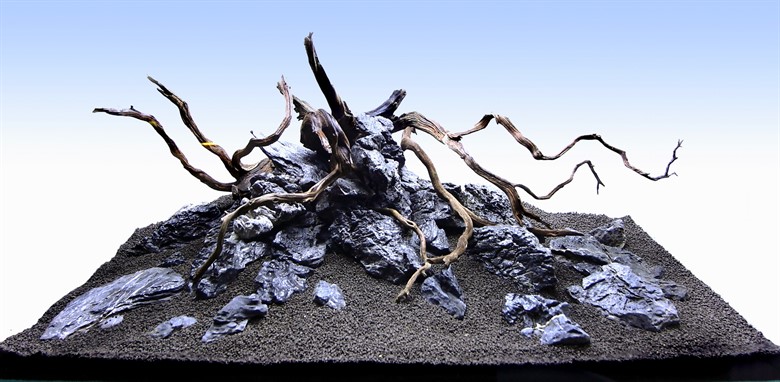Planning your aquarium is a prerequisite for achieving good results. Gain inspiration at your local dealer or at tropica.com before making your final choice. Spend the necessary time on planning - and by all means on drawing - the layout with the location of both decoration materials and plants.

Hardscape is an aquarium layout with gravel, rocks, tree roots and other decorations - but no plants. Creating a hardscape is entirely up to your imagination. Some find it extremely interesting, others do not like it so much. You can compare this activity to standing before an easel and working with the paint brush. Most of us try to do their best, whereas diligent artists understand the colour setting, depth and perspective. Many competitions are arranged around the world to determine the aquascaper who can create the most impressive aquarium design. We can recommend that you start with hardscapes, no matter whether you have the talent of an artist or not…!
- Find the appropriate pieces of wood, rocks, stones and other decorative elements you want to use in your hardscape. If you choose heavy stones, we can recommend adding polystyrene at the bottom in order to protect the glass.
- Add about 1 cm substrate in the places where plants with strong roots will be planted. We recommend Tropica's Plant Growth Substrate.
- The bottom layer, which often consists of gravel, is carefully distributed and it can slope upwards towards the rear wall of the aquarium. This way you achieve depth and perspective in your aquarium.
- Finally, place the rocks, tree roots and any other decoration you like. Move around individual components and change their places, if necessary. It is now that you create room and perspective so that the aquarium layout design is just right for you.
The substrate retains the plant roots, ensures a good water circulation around the roots and binds the nutrients, which the roots can absorb.
Different kinds and colours of gravel with a grain size from 0,8-4 mm will ensure a good water circulation, but make sure that the ground layer does not liberate harmful substances into the water. Under the gravel, a layer of ½-1 cm substrate is added, which binds nutrients for the roots. Some products combine gravel and a nutrient medium in one and the same product, other products are concentrated substrates. Contrary to the gravel, the substrate offers nutrients in the form of minerals, which contribute to creating an acid and highly nutritious environment to the benefit of the root development and nutritious intake of the plants.
By the start-up of the aquarium, the substrate is spread with the main part into places, where plants with strong roots are to be planted later. After that, the gravel is distributed over the entire ground of the aquarium. The gravel is divided sloping upwards and backwards with at least 3-4 cm in the front and 6-8 cm in the back. In places where big rocks are to be placed later, a thin styrene plate can be placed before the substrate and gravel in order to protect the glass bottom.